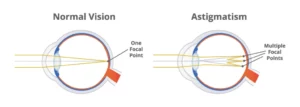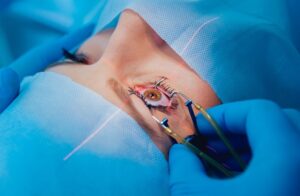Astigmatism is a very common condition and can be found in 1 out of 3 people. However, this condition is treatable and PRK is one of the effective options available. In this blog, we will explore how PRK offers an effective solution to correct astigmatism. We’ll discuss the advantages, procedure, its comparison with LASIK, and other essential details. If you’re curious about PRK and astigmatism, then valuable insights in this blog will help you make an informed decision.
Contents
What Is Astigmatism?
 Astigmatism is a common eye condition that affects the shape of the cornea or the lens of the eye. It occurs when the cornea or lens is not perfectly curved, leading to blurred or distorted vision at various distances. Instead of being spherical, the cornea or lens may have an irregular shape, causing light rays to focus unevenly on the retina. Astigmatism can be corrected with glasses, contact lenses, or refractive surgery.
Astigmatism is a common eye condition that affects the shape of the cornea or the lens of the eye. It occurs when the cornea or lens is not perfectly curved, leading to blurred or distorted vision at various distances. Instead of being spherical, the cornea or lens may have an irregular shape, causing light rays to focus unevenly on the retina. Astigmatism can be corrected with glasses, contact lenses, or refractive surgery.
Symptoms In This Condition
Astigmatism can cause the following symptoms:
- Blurred vision: Objects at various distances may appear blurry or distorted. Both near and far vision can be affected.
- Distorted vision: Straight lines may appear wavy or bent, leading to a perception of distorted images.
- Eye strain: Prolonged visual tasks, such as reading or using digital devices, may result in eye fatigue, discomfort, or headaches.
- Difficulty with night vision: Astigmatism can contribute to difficulties seeing clearly in low-light conditions or at night.
- Squinting: People with astigmatism may instinctively squint in an attempt to improve their focus and clarity of vision.
- Eye discomfort: Astigmatism can cause general eye discomfort, such as itching, burning, or a feeling of dryness.
Can PRK Treat Astigmatism?
 Yes, PRK (Photorefractive Keratectomy) can be used to treat astigmatism. PRK is a type of laser eye surgery that reshapes the cornea to correct refractive errors, including astigmatism. During this, the surgeon uses a laser to remove a thin layer of tissue from the surface of the cornea, which helps to reshape it and improve its focusing ability. By modifying the cornea’s curvature, PRK can effectively correct astigmatism and improve vision. However, the suitability of PRK for astigmatism correction depends on various factors, and it is important to consult with an eye care professional to determine the most appropriate treatment option for individual circumstances.
Yes, PRK (Photorefractive Keratectomy) can be used to treat astigmatism. PRK is a type of laser eye surgery that reshapes the cornea to correct refractive errors, including astigmatism. During this, the surgeon uses a laser to remove a thin layer of tissue from the surface of the cornea, which helps to reshape it and improve its focusing ability. By modifying the cornea’s curvature, PRK can effectively correct astigmatism and improve vision. However, the suitability of PRK for astigmatism correction depends on various factors, and it is important to consult with an eye care professional to determine the most appropriate treatment option for individual circumstances.
What Is The PRK Procedure For Astigmatism?
The PRK (Photorefractive Keratectomy) procedure for astigmatism involves several steps:
- Anesthesia: The eye is numbed using eye drops or a local anesthetic to ensure a painless procedure.
- Removal of the epithelium: The thin outer layer of the cornea called the epithelium is gently removed. This can be done manually with a surgical instrument or using a laser.
- Corneal reshaping: A laser, typically an excimer laser, is used to reshape the cornea’s surface. The laser precisely removes small amounts of tissue from specific areas of the cornea to alter its curvature and correct astigmatism. The exact pattern of tissue removal is determined based on the individual’s unique astigmatism.
- Medication and protection: After the corneal reshaping, medication is applied to the eye to promote healing. A soft contact lens or a bandage contact lens may be placed on the eye to protect the cornea during the initial healing process.
- Healing and recovery: Over the following days and weeks, the epithelium regenerates and covers the treated area. During this time, the cornea gradually stabilizes, and vision improves. It is essential to follow the post-operative instructions provided by the surgeon regarding medication use, eye protection, and follow-up appointments.
- Follow-up appointments: Multiple follow-up visits are scheduled to monitor the healing process and evaluate the effectiveness of the PRK procedure. These visits help ensure that the cornea is healing properly and that the desired visual outcome is achieved.
Advantages Of PRK For Astigmatism
 PRK (Photorefractive Keratectomy) offers several advantages as a treatment option for astigmatism:
PRK (Photorefractive Keratectomy) offers several advantages as a treatment option for astigmatism:
- Effective astigmatism correction: PRK is highly effective in correcting astigmatism. The laser reshaping of the cornea allows for precise modification of its curvature, resulting in improved focusing ability and clearer vision.
- Safe and proven technique: PRK has been performed for many years and has a proven track record of safety and effectiveness. It is an established procedure supported by extensive research and clinical experience.
- Suitable for various astigmatism levels: PRK can be used to treat a wide range of astigmatism, including mild, moderate, and even higher degrees of astigmatism. The procedure can be customized to address the specific needs of each individual.
- Long-term stability: PRK has shown excellent long-term stability in correcting astigmatism. Once the cornea has healed and stabilized after the procedure, the astigmatism correction is generally permanent, providing lasting visual improvement.
- No risk of flap-related complications: Unlike LASIK (another laser eye surgery procedure), PRK does not involve creating a corneal flap. This eliminates the risk of flap-related complications, such as flap dislocation or epithelial ingrowth, which can occur in LASIK.
- Suitable for individuals with thin corneas: PRK is a good option for individuals with thin corneas who may not be suitable candidates for LASIK. Since PRK does not require the creation of a corneal flap, it preserves more corneal tissue, making it a viable option for those with thinner corneas.
- Reduced risk of dry eye: Some studies suggest that PRK may have a lower risk of inducing or exacerbating dry eye symptoms compared to LASIK. This can be beneficial for individuals who are prone to dry eye or have pre-existing dry eye conditions.
What Is Better For Astigmatism: PRK or LASIK?
 The choice between PRK (Photorefractive Keratectomy) and LASIK (Laser-Assisted in Situ Keratomileusis) for astigmatism correction depends on various factors and should be determined on an individual basis in consultation with an experienced eye care professional. Both PRK and LASIK can effectively treat astigmatism, but they differ in certain aspects:
The choice between PRK (Photorefractive Keratectomy) and LASIK (Laser-Assisted in Situ Keratomileusis) for astigmatism correction depends on various factors and should be determined on an individual basis in consultation with an experienced eye care professional. Both PRK and LASIK can effectively treat astigmatism, but they differ in certain aspects:
Corneal involvement
In PRK, the thin outer layer of the cornea (epithelium) is removed before laser reshaping, while in LASIK, a corneal flap is created and lifted to access the underlying tissue for laser treatment. PRK involves reshaping the cornea directly, while LASIK involves reshaping the underlying corneal tissue after the flap is created.
Recovery time
PRK typically involves a longer recovery period compared to LASIK. After PRK, the regrowth of the epithelium and complete corneal healing may take several days to a few weeks, during which vision may be temporarily blurry or hazy. LASIK generally offers quicker visual recovery and less discomfort in the early post-operative period.
Corneal thickness
PRK is suitable for individuals with thinner corneas since it does not require the creation of a corneal flap like LASIK does. If the cornea is relatively thin, PRK may be a safer option to preserve corneal integrity.
Risk of complications
LASIK has a slightly higher risk of flap-related complications, such as flap dislocation or epithelial ingrowth, which are not present in PRK. PRK eliminates the possibility of flap-related issues because it does not involve the creation of a corneal flap.
Dry eye risk
Some studies suggest that PRK may have a lower risk of inducing or exacerbating dry eye symptoms compared to LASIK. This may be important for individuals who have a pre-existing dry eye condition or are prone to dry eye.
Patient preferences and lifestyle
 Some individuals may prefer PRK due to its suitability for thinner corneas, avoidance of flap-related concerns, or personal preferences. Others may prefer LASIK for its faster recovery time and potential for quick visual improvement.
Some individuals may prefer PRK due to its suitability for thinner corneas, avoidance of flap-related concerns, or personal preferences. Others may prefer LASIK for its faster recovery time and potential for quick visual improvement.
Ultimately, the choice between PRK and LASIK for astigmatism correction depends on individual factors such as corneal thickness, eye health, lifestyle, and patient preferences. An eye care professional can conduct a thorough evaluation and provide personalized recommendations based on your specific circumstances.
Conclusion
In conclusion, PRK (Photorefractive Keratectomy) is an effective treatment option for astigmatism. By reshaping the cornea using laser technology, PRK helps correct the irregularities in corneal curvature, leading to improved vision. It is a safe and proven procedure with long-term stability. However, the choice between PRK and other options should be made in consultation with an eye care professional. If you are experiencing astigmatism symptoms, seek help from an experienced eye care provider to explore the best treatment approach for your specific needs.
Lasik surgery is a safe 10-minute procedure to help you get rid of glasses. EyeMantra offers the most advanced LASIK options including PRK, Femto LASIK, SMILE surgery, Standard LASIK, ICL, and Contoura vision. If you have any questions on LASIK surgery in Delhi, Lasik surgery cost, and Lasik procedure, call us at 9711116605 or email at [email protected].



mexican pharmaceuticals online: cmqpharma.com – mexican rx online
mexican mail order pharmacies
http://cmqpharma.com/# medicine in mexico pharmacies
purple pharmacy mexico price list
п»їbest mexican online pharmacies: mexico pharmacy – mexican rx online
canadian online pharmacy canadian pharmacy 365 online pharmacy canada
reputable canadian pharmacy: canadian pharmacy india – canadian pharmacy no rx needed
onlinecanadianpharmacy 24: onlinepharmaciescanada com – canadian neighbor pharmacy
http://canadapharmast.com/# pharmacy canadian superstore
indianpharmacy com buy prescription drugs from india buy medicines online in india
pharmacies in canada that ship to the us: canadian online pharmacy reviews – canada pharmacy 24h
https://indiapharmast.com/# cheapest online pharmacy india
mexican mail order pharmacies mexico pharmacies prescription drugs pharmacies in mexico that ship to usa
canadian drug: canada drugstore pharmacy rx – best canadian online pharmacy
reputable mexican pharmacies online: buying prescription drugs in mexico – buying prescription drugs in mexico
escrow pharmacy canada: medication canadian pharmacy – canadian pharmacy online reviews
ed drugs online from canada: my canadian pharmacy review – canadianpharmacymeds com
http://foruspharma.com/# mexican border pharmacies shipping to usa
https://clomiddelivery.pro/# cost clomid without rx
http://doxycyclinedelivery.pro/# doxycycline 500mg
cost of amoxicillin 30 capsules: over the counter amoxicillin canada – order amoxicillin 500mg
http://clomiddelivery.pro/# generic clomid online
doxycycline 100 mg india: doxycycline 100 mg forsale outside the us – doxycycline otc
http://paxloviddelivery.pro/# п»їpaxlovid
http://doxycyclinedelivery.pro/# where can i get doxycycline
ciprofloxacin: cipro for sale – buy cipro online canada
https://clomiddelivery.pro/# can you buy generic clomid without a prescription
http://paxloviddelivery.pro/# paxlovid india
paxlovid pharmacy: Paxlovid over the counter – paxlovid pharmacy
https://amoxildelivery.pro/# amoxicillin no prescipion
paxlovid price: Paxlovid buy online – paxlovid india
https://paxloviddelivery.pro/# paxlovid buy
clomid without prescription: how to get generic clomid without a prescription – can you buy cheap clomid
where to buy cipro online: buy cipro online canada – buy ciprofloxacin over the counter